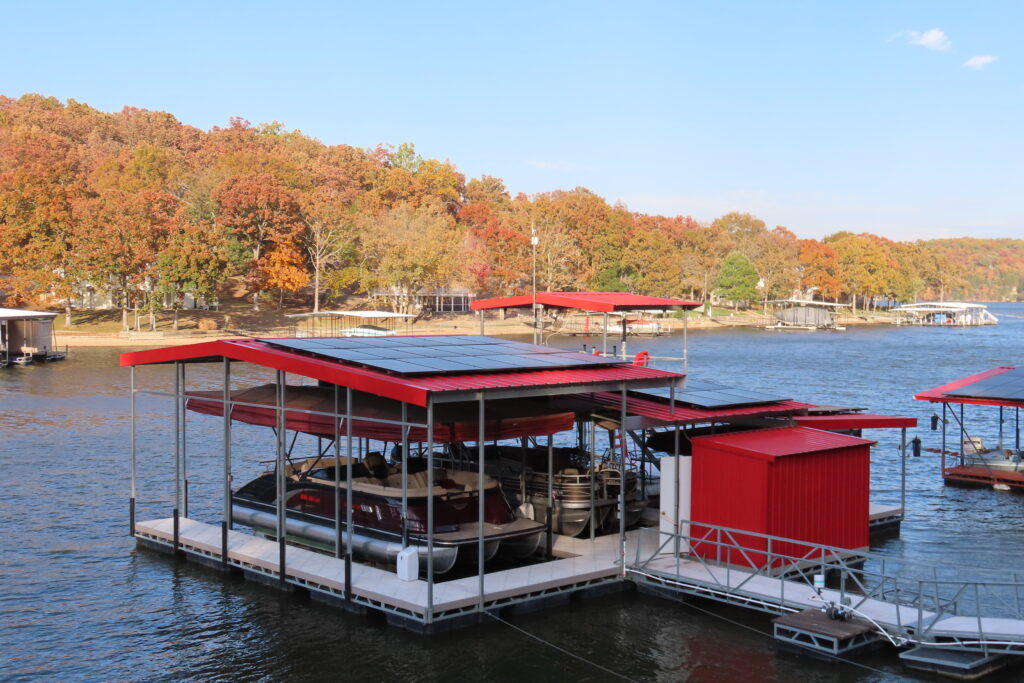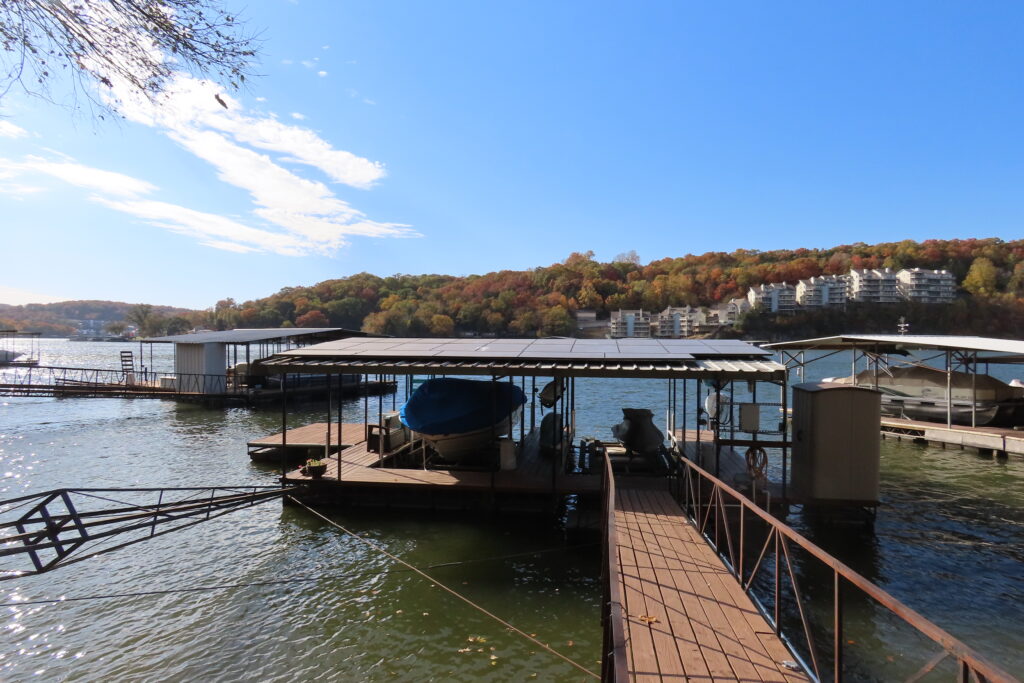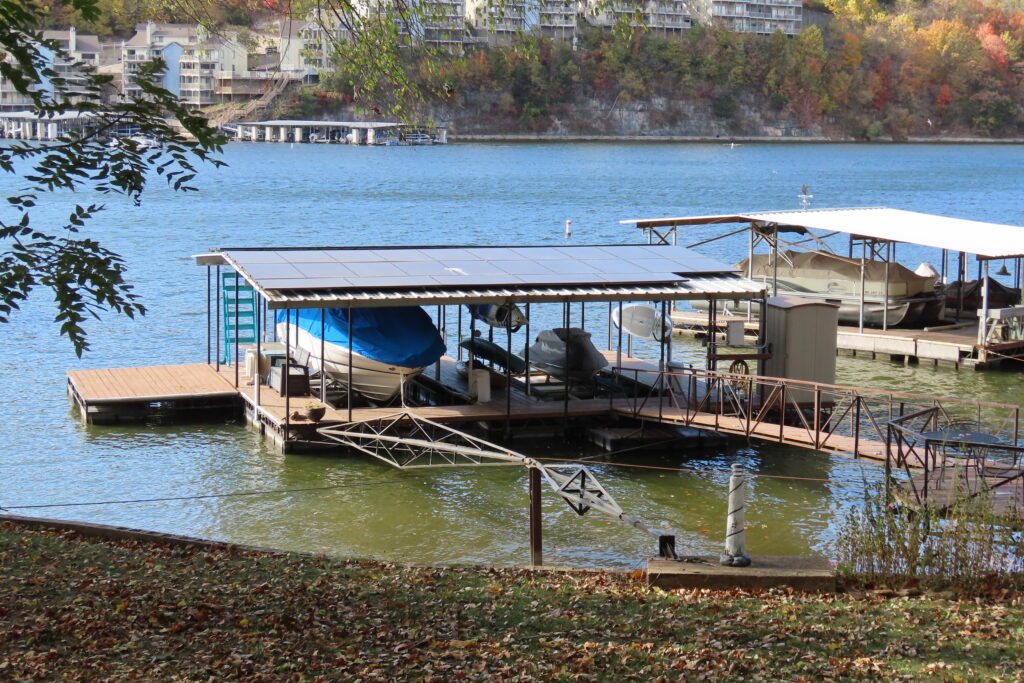Lake of the Ozarks is especially suited for solar, and lakefront homeowners are discovering it.

Photo courtesy of Randy Grommet
by Kate Robbins & Nathan Bechtold
The Lake was built for energy. While Union Electric figured their new lake would have recreational potential, they were primarily focused on the hydroelectric dam that would create it. Nearly a century later, the dam is still powering Missourians’ homes, but many Lake of the Ozarks homes are tapping into a new source of electricity: the sun. Springfield-based Sun Solar has been serving central Missouri’s solar needs since 2012, and energy consultant Randy Grommet says lakefront homeowners are seeing the light.
“It’s one of the few things that you can permanently make yourself inflation-proof on,” said Grommet, who has been involved with solar since 2007. In 2009, he started his own solar company, grew it, and sold it. Now he lives at Lake of the Ozarks — and has solar on his boat dock — and helps homeowners and businesses save money by going solar. “You can lock in the cost of what you’re paying for electricity for the rest of your life,” he explained.

Photo courtesy of Randy Grommet
Grommet says he’s finding churches and nonprofit organizations are increasingly interested in solar; he says it means “instant savings” for those organizations, as their payment on their solar system (which is designed to offset all their energy usage) is often significantly lower than their monthly electric bill. “A few [nonprofits] that I went back to recently to check on, they were saving like 10 percent versus what they’d been paying for electric,” he said. He loves introducing those organizations — which often have sizable facilities and run on tight budgets — to those kinds of savings.
“You can lock in the cost of what you’re paying for electricity for the rest of your life!”
Sun Solar has installed more than 160,000 solar panels over the course of the company’s history. These solar panels have resulted in more than $9 million in utility bill savings for Sun Solar customers. The company is finding as the Lake’s population grows, and many former urban dwellers arrive on its green shores, more and more new homeowners are interested in solar.

Photo courtesy of Randy Grommet
Lake of the Ozarks is perfectly suited for solar panels in more ways than one: second-homeowners who rent their home to vacationers are especially good candidates for solar. Grommet pointed out, “For anybody that has a second-home that they use as an AirBnB — those [renters] are not mindful of electricity usage — solar is awesome!” That’s because solar panels are cranking out the most energy in the peak of summer: also the peak of tourist season. For systems hooked into the grid, Missouri utility companies offer an energy credit if a homeowner’s solar panels generate more electricity than the home uses. The surplus power goes back into the grid, and the company credits the homeowner’s bill: then, in the lower-generating winter months, those credits help cover any extra electrical usage.
Grommet also points to the significant tax credits and rebates for households considering solar panels: they can help defray the cost of installation, the structure and the panels themselves. Uniquely at Lake of the Ozarks, docks and dock roofs are ideal structures for panels, since they’re in full-sun and homeowners don’t have to choose between solar panels or shade trees around the house. “If you have a boat dock, it’s the one place that’s never in the shade,” Grommet noted. (Contact him for more information about tax credits and other financial incentives, which are subject to change.)
Tired of high electric bills, or just ready to go solar? Contact Randy Grommet with Sun Solar, at (573) 317-6622. Or email rgrommet@ussunsolar.com. Learn more online at ussunsolar.com.

I have a 5 kW solar system on my garage at the Lake. It feeds into the CoMo grid when I’m not using. What isn’t mentioned in the article is that CoMo buys the excess from me for $0.02/kWh and sells me electricity at $0.08/kWh. You have to generate 4x the power you draw to break even on the electricity cost. In addition, CoMo charges a $35/month availability fee and variable demand charge. If I generate more than I use in a month, sure I get a credit at $0.02 but the access and demand are charged regardless. While it’s a great way to offset electric costs, with CoMo’s business model it’s not a quick payback proposition.